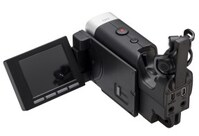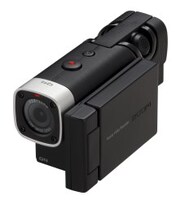 The new product that had everybody excited at the 2014 Winter NAMM tradeshow in Anaheim was the Zoom Q4 camcorder, intended to compete in the “head-cam, personal POV, miniature camera” market.
The new product that had everybody excited at the 2014 Winter NAMM tradeshow in Anaheim was the Zoom Q4 camcorder, intended to compete in the “head-cam, personal POV, miniature camera” market.
The Q4 is small and lightweight. It will fit within the palm of your hand (or in your shirt pocket). List price is $374, but most dealers offer it for the MAP of only $299.
A couple of the features that caught everyone’s eye was the more traditional ergonomics of the unit, along with the ability to record 1080/30HD video MPEG-4 AVC/H.264 (MOV)) along with professional grade audio up to 24bit/96k!
Of course you can choose to record video and audio at a wide variety of lesser settings and smaller file sizes:
HD 1080p/30fps, HD 720p/60fps, HD 720p/30fps, WVGA 60fps, WVGA 30fps.
WAV (16/24-bit quantization, 44.1/48/96kHz sampling frequency , AAC (64 – 320kbps bit rate, 48kHz sampling frequency).
The Q4 handles like a traditional camcorder, not a flat pocket still camera. It has a flip out viewfinder that rotates front to back. The viewfinder module slides off of the camera body entirely if you need to conserve size, mass, or power. The Q4 menu allows you to invert the video, so that you can operate the camera suspended upside down, which is handy if you hang the camera from its ¼-20 tripod socket (on the bottom of the Q4).
The lens is a fixed wide angle. However, a touch of the button instantly cuts to a 4X narrower view. So, in effect, you can alternate (live) between two angles of view. The specs lead one to believe that minimum focus is 55 cm (22 inches), but I had no problem shooting objects just a couple inches away from the lens.
Exposure and white balance are auto. There are 3 exposure settings available: normal auto; Concert (backlight); and Night (high gain).
I tried a test using a (nightvision) IR illumination array that I use with my surveillance camera. The Q4 did see the IR led’s glowing brightly, but was not sensitive enough in that spectrum to see anything “lit” by the array.
 Let’s look at the audio. The Q4 features a flip-up X-Y stereo microphone, which is far superior to the typical “on-board” camcorder mikes.
Let’s look at the audio. The Q4 features a flip-up X-Y stereo microphone, which is far superior to the typical “on-board” camcorder mikes.
On the back of the camera is a stereo mini headphone jack, with volume variably controlled by a rocker switch on the side. That jack can also serve as a line level output instead.
Also on the rear of the camera is a stereo mini input jack, for mic or line level external input. A menu selection can activate a volt or two of “mic powering” for consumer electret units. (Do not confuse this for professional Phantom powering.)
Input level options include auto gain or manual gain. In the Auto mode, there are choices for Concert (loud), Solo performance (not so loud), or Meeting (normal). The manual gain switch also only provides for three choices, but is selectable on the side of the camera rather than via the menu. The viewfinder meters accurate audio levels in dB.
Although I would have preferred completely variable input levels, at least the 3 settings get me close enough that I can make more precise ref level adjustments from my mixing panel.
I ran some tests and discovered that Zoom's definition of LINE LEVEL INPUT is questionable, in practice. Technically, they are correct. I sent a -10dB test tone into the Q4 (set to manual audio) and it landed (on the lowest sensitivity setting) at -6dB. It cleared it, but not by much! When I selected a +4dB tone output, the signal blew off the Q4 meter scale.
Next, I pumped the tone generator into my Mackie 1402 panel, and set my output to zero on the Mackie meters. Normally, when I output the Mackie to a digital recorder, I adjust Mackie zero to -20dB on the recorder. Zero out of the Mackie, into the Q4, blew off the scale. If I depressed the built-in attenuator switch on the back of the 1402, which knocks around -35dB off of the main outputs (Mackie calls it a mic/line button), then of course I had no problem going in to the Q4.
I tried using my XLR-PRO adapter box (similar to a BeachTek) and of course that had no problem converting a hot line signal down to a Q4 acceptable mic level input. But the Q4 does not require a full -50dB line to mic conversion; simply using an inline attenuator pad that could knock off -20 to -30dB is fine.
What sets the Q4 apart is the ability to record audio in professional formats, such as 24bit/96k or the more commonly used 24bit/48k. Of course, you can also choose 16bit, or 44.1k -- or even lower bit rates (though I cannot imagine why).
Using the Q4 is easy. Files can be immediately played back by pressing a button from the home screen. Alternately, you can menu thru to the Files area and select files for playback or deletion.
Connect to your computer via the (supplied) USB cable. The Q4 does not come with an external battery charger, but charges within the camera via USB. You can purchase a separate USB power supply if you prefer not to tie up your computer.
With the USB connected, the Q4 acts as a guest drive (card reader), and you can access the files just as you would with a still camera. You can play the files thru the USB connection and view them on your computer screen, or you can copy them directly to your hard drive. They show up as MOV files, which play in QuickTime or may require a different media player, depending on your computer configuration. (Even though I have QT on my laptop, the Windows 8.1 requires a different media player.) Just as with a still camera, you can edit the SD card of the Q4 through your computer access.
Speaking of QuickTime, I did discover that the Q4 codec did not work in some of the older video editing programs, such as Adobe Premiere CS5. You can use QuickTime Pro to export the files into a friendlier version of H.264 or a wide variety of other formats.
To output the video files from the Q4 directly to a monitor or projector, you need to purchase an HDMI to Micro type D output cable (which seem to run around $10-30 around town). I have discovered that when you output audio via the HDMI, you need to make sure that the headphone output is not set too high, or else you will hear hiss on the soundtrack.
Oh, and in case your are wondering --- I actually went out and purchased my Q4 with my own money. Although I had spoken to Zoom about the possibility of them sending me a unit to review, I never heard back from them and decided not to wait. This camcorder was perfect for my needs!
It fits into my pocket, so I can carry it around while hiking, sightseeing, or at events. When I teach college classes or workshops, the camera allows me to show close-up detail on a large monitor. Often, during my courses or workshops, we record production sound direct to video from a mixing panel so that the class can review the playbacks. In the past, I have utilized bulky 3-chip camcorders. But the Q4 affords me the same technique, but with one less heavy case to ship.
Zoom did not offer any spare batteries for the Q4. They do, however, offer an AC powered USB charger that allows you to recharge the camera battery inside of the camera, without having to connect to a computer host.
But there is a better solution. Turns out that the Zoom Q4 uses a Samsung SLB-10 (SLB-10a) style lithium battery. So if you run an internet search for that battery, you will find spare batteries in the $10 to $20 range. I just purchased one from batteries4less.com and it ran me $12 for the battery. I was also able to purchase an external battery charger (AC or 12v CIG) for another $18 -- which is more convenient than having to use the camera as a charger!
A note regarding use of SD cards. Most SD cards work just fine for 30p settings. However, to record at 720/60p -- you must have a high speed card or else the camera will drop out of RECORD mode within a second or two. At first, that was driving me crazy, until I swapped out SD cards with my still camera. Then the dropped recording problem went away. Slower SD cards are way cheaper, so you might consider owning a larger capacity card for "normal" video, and maybe a smaller capacity high speed card for when you need 60p (if you do not do a lot of 60p videography). Or, just invest one time in a high speed large capacity card!
The Q4, at under $300, might also serve as an excellent introductory camera for basic filmmaking. Not having a zoom lens forces the students to be more cognizant of camera placement and setups. I still remember back to when I was a student and our first film assignments were done with fixed lenses, lest we fall victim to zoom-fluenza.
I purchased mine from Sweetwater for $299, no sales tax, free shipping, and three monthly payments. There are many other dealers out there with similar pricing, so shop where you feel comfortable.
Here is the link to the Zoom Q4 website:
https://www.zoom-na.com/products/field-video-recording/video-recording/zoom-q4-handy-video-recorder
and here is the link to the Q4 Users manual:
https://www.zoom-na.com/sites/all/themes/zoom/downloads/q4/pdfs/Q4_userGuide_English.pdf
